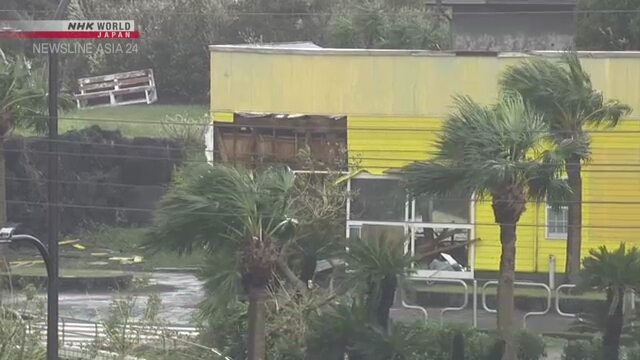Japan’s Meteorological Agency downgraded a heavy rain emergency warning for Tokyo’s Hachijo Town in the Izu island chain to a warning at 2:30 p.m. on Thursday. Weather officials are asking local residents to stay on alert for an increased risk of landslides after Typhoon Halong moved to waters east of Japan.
Hachijojima Island had 284.5 millimeters of rain during a six-hour period through 7:20 a.m. That is a record since statistics became available in 2003. The record rainfall was brought by stationary bands of heavy rain clouds that formed over the island in the early hours of Thursday.
A landslide warning has been issued for Hachijojima as the record-breaking rain has loosened the ground in some places.
Landslides have occurred in the past on Hachijojima after heavy rain stopped.
The Izu Islands, along with the Kanto region on the main island of Honshu, are still within the typhoon’s zone of strong wind.
It will continue to be extremely windy in those regions, and high waves are likely at sea.
Earlier, Japan’s Meteorological Agency issued a heavy rain emergency warning for Hachijo Town on one of the islands. It is urging people to remain on the highest alert.
As of 11:00 a.m. on Thursday, the southern part of the island chain was in the typhoon’s storm zone. The islands had had torrential rain since the early morning.
Agency officials urged people in Hachijo Town to do everything possible to stay safe as it is highly likely that mudslides and other disasters have already occurred.
The agency also issued information on significant rainfall for the southern Izu Islands shortly after 8:30 a.m., saying that bands of heavy rain clouds had formed over the region.
Areas around Hachijo Town were estimated to have had more than 120 millimeters of rain in the hour through 5:30 a.m. and about 100 millimeters in the hour through 7:00 a.m.
The agency had issued emergency warnings for storms and high waves for Hachijo Town and the villages of Aogashima, Toshima, Niijima, Kozushima, Miyake and Mikurajima but switched them to warnings and advisories shortly before noon.
Peak gusts during the three hours through 10:00 a.m. clocked more than 190 kilometers per hour at Hachijojima Airport, more than 160 kilometers per hour on Hachijojima Island, and more than 120 kilometers per hour on Miyakejima Island.
People on the Izu Islands are advised to remain on alert for several more hours for gale-force winds that can destroy buildings.
A maximum wind velocity of 180 kilometers per hour is forecast for Thursday, and peak gusts of more than 250 kilometers per hour.
Strong winds are also forecast for the Kanto region, which includes Tokyo, mainly offshore.
The expected maximum wind velocity is 90 kilometers per hour, and peak gusts could reach more than 120 kilometers per hour.
A storm warning has been issued for the south of Chiba Prefecture.


AloJapan.com